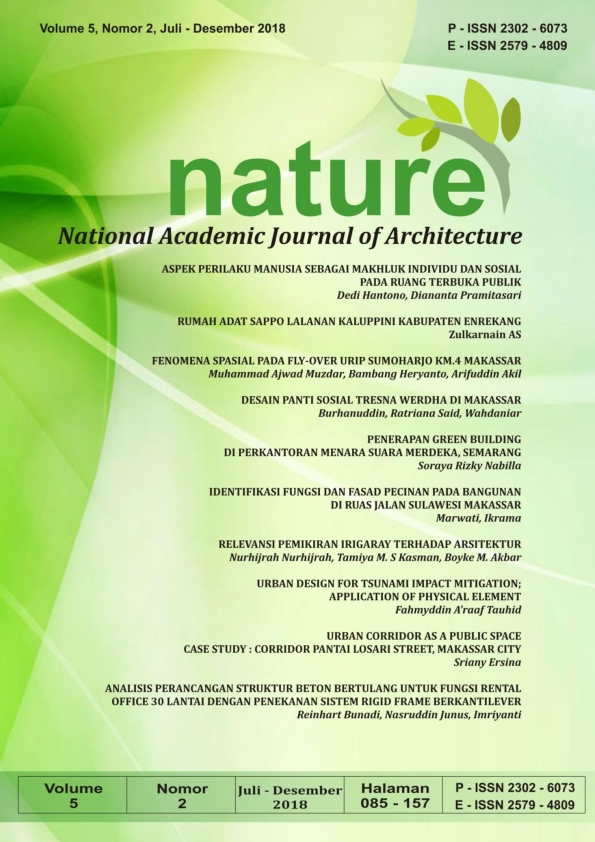URBAN DESIGN FOR TSUNAMI IMPACT MITIGATION; APPLICATION OF PHYSICAL ELEMENT
Abstract
Abstract_ The increasing of tsunami event has called the integration of urban design for disaster impact mitigation. The Geodynamics position of many global cities puts latter areas are highly vulnerable to earthquake followed by tsunamis. In supporting its function as the main hub in social and economic and protecting environment, the employment of urban design for tsunami impact mitigation is hypothesized as sustainable mean. Therefore, this paper seeks the possibility of employment of urban design’s physical element for tsunami impact mitigation within disaster studies field using literature and case studies for Indonesian cities context. This study recommends that Infrastructure planning and design, Coastal forest, Early warning system, Emergency road network planning, Pre-tsunami evacuation planning and Building design and construction are suitable physical element for impact mitigation.
Keywords: Urban Design; Tsunami; Mitigation; Physical Element.
Downloads
References
Aksornkaoe, S. et al. (1993). Effect of sea level rise on the mangrove ecosystem in Thailand.Malaysian Journal of Tropical Geography . Vol 24, pp. 29-34.
Alesch, D., & Arendt, L. (2012). Natural hazard mitigation policy: Implementation, organizationalchoice, and contextual dynamics. Dordrecht: Springer.
Alongi, D. M. (2008). Mangrove forests: Resilience, protection from tsunamis, and responses to global climate change. Estuarine, Coastal and Shelf Science. No. 76, pp 1-13
BAPPENAS (2005). Master Plan for the Rehabilitation and Reconstruction of the Regions and Communities of the Province of Nanggroe Aceh Darussalam and the Island of Nias, Provinceof North Sumatera. Jakarta: Badan Perencanaan Pembangunan Nasional (Bappenas) Republik Indonesia. Available at http://www.e-aceh-nias.org/index.php?id=master_plan.html.
Barbier, E.B. (2008). In the wake of tsunami: Lessons learned from the household decision to replant mangroves in Thailand. Resource and Energy Economics. No. 30, pp.229–249
Brinkman, R.M. et al. (1997). Surface wave attenuation in mangrove forests. Proceedings of 13th Australasian Coastal and Ocean Engineering Conference . No.2, pp. 941-949.
Budiarjo, A. (2006). Evacuation Shelter Building Planning for Tsunami-prone Area; a case study of Meulaboh City, Indonesia. Thesis. ITC, Eschende, The Netherland.
Chang, S.E., et al. (2006). Coastal ecosystems and tsunami protection after the December 2004 Indian Ocean tsunami. Earthquake Spectra . Vol. 22, pp.863-887.
Chatenoux, B. et al. (2007). Impacts of the 2004 Indian Ocean tsunami: analysing the potential protecting role of environmental features. Natural Hazards . Vol.40, pp.289-304
Chmutina, K., Ganor, T., & Bosher, L. (2014). Role of urban design and planning in disaster risk reduction. Proceedings of the Institution of Civil Engineers - Urban Design and Planning,167(3), 125-135. doi:10.1680/udap.13.00011
Eisner, R. (2005). Planning for Tsunami: Reducing Future Losses Through Mitigation. Developing Tsunami-Resilient Communities, 155-162.
Farreras, S., & Sanchez, A. (1991). The Tsunami Threat on the Mexican West Coast: A Historical Analysis and Recommendations for Hazard Mitigation. Tsunami Hazard, 301-316.
FEMA (2015). What is mitigation?. Available at https://www.fema.gov/what-mitigation
Geis, E. (2000). “By Design: The Disaster Resistant and Quality-of-Life Community.” Natural Hazards Review, Vol. 1, No. 3, August, pp. 151-160.
Ghobarah, A., Saatcioglu, M., &Nistor, I. (2006). The impact of the 26 December 2004 earthquake and tsunami on structures and infrastructure. Engineering Structures, 312-326.
Haque, C. (2005). Mitigation of natural hazards and disasters international perspectives. Dordrecht: Springer.
ICE (1992) Coastal Structures and Breakwaters. Proceedings of the Conference coastal engineering 1992. Institution of Civil Engineers, Great Britain.
JICA (2005). The Study on the Urgent Rehabilitation and Reconstruction Support Program for AcehProvince and Affected Areas in North Sumatra. Japan International Cooperation Agency (JICA), Badan Perencanaan Pembangunan Nasional (Bappenas), and Provincial Government of Nanggroe Aceh Darussalaam, Banda Aceh.
Lunecke, M. (2015). Urban planning and tsunami impact mitigation in Chile after February 27, 2010. Nat Hazards Natural Hazards, 1591-1620.
Løvholt, F., Glimsdal, S., Harbitz, C., Zamora, N., Nadim, F., Peduzzi, P.,Smebye, H. (n.d.).(2013). Tsunami hazard and exposure on the global scale. Earth-Science Reviews, 58-73. doi:10.1016/j.earscirev.2011.10.002
MCDEM (2008). National Tsunami Signage Technical Standard for the CDEM Sector. Wellington: Ministry of Civil Defence& Emergency Management
Mileti, D. (1999). Disasters by design: A reassessment of natural hazards in the United States. Washington, DC: Joseph Henry Press.
Mikami, T., Kinoshita, M., Matsuba, S., Watanabe, S., &Shibayama, T. (2015). Detached Breakwaters Effects on Tsunamis around Coastal Dykes. Procedia Engineering, 422-427.
Morrissey, W. A. (2005). Tsunamis: Monitoring, Detection, and Early Warning Systems CRS Report for Congress January 24, 2005. Washington: USA Congress report.
NTHMP (2001). Designing for tsunamis seven principles for planning and designing for tsunami hazards. [Seattle, Wash.], National Tsunami Hazard Mitigation Program. Sacramento, U.S 2001.
Papathoma, M. et al. (2003). Assessing tsunami vulnerability, an example from Herakleio, Crete Natural Hazards and Earth System Sciences. No.3, pp.377–389.
Pelling, M. (2003). The vulnerability of cities: natural disasters and social resilience. London: Earthscan Publications.
Shibayama, T., Esteban, M., Nistor, I., Takagi, H., Thao, N., Matsumaru, R Ohira, K. (2013). Classification of Tsunami and Evacuation Areas. Nat Hazards Natural Hazards, 365-386.
World Bank and Badan Rehabilitasi dan RekonstruksiAceh,Aceh Province government (2008).The Impact of the Conflict, the Tsunami and Reconstruction on Poverty in Aceh:ACEH POVERTY ASSESSMENT 2008.world bank: Jakarta.
Zschau, J. (2003). Early warning systems for natural disaster reduction. Berlin: Springer.
Copyright (c) 2019 Fahmyddin A'raaf Tauhid

This work is licensed under a Creative Commons Attribution-ShareAlike 4.0 International License.
By submitting your manuscript to our journal, you are following Copyright and License











